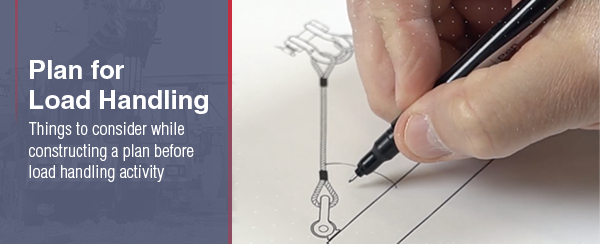Having championed the role of the rigger and emphasizing the value of professionals who attach equipment that lifts, moves, or secures complex, critical, and heavy objects in one of my last posts, it’s timely to drill down into the sector a little deeper to examine some of the things that should be considered while gathering the facts needed to construct a solid plan before commencing the load handling activity (LHA). Plan ahead and think it through because lives and loads are at stake.
This is not an all-inclusive list—your application may dictate even more requirements.
Consider the load.
- Is the size, shape, and weight of load known?
- Is the location of the center of gravity known?
- Does it have adequate pick points?
- Is the load fragile or have internal components that could shift and need to be secured?
- Does the load have sharp edges, protrusions, abrasive surface, corners, etc. that could damage the slings?
- Have environmental or hazardous concerns been considered such as acids, alkalis, etc. that could affect the slings?
- Are there any temperature concerns that would impact sling and rigging hardware selection?

Consider load handling equipment (LHE).
- Are you going to use a mobile crane?
- Are you going to use a winch?
- Must you bull rig to a supporting structure and use a chain hoist and/or block system?
- Will the load need to be lifted, jacked, or pulled?
- Is there a connection point to collect the slings?
- Does the LHE have the capacity that is needed?
- Will the LHE provide a smooth movement of the load without introducing additional dynamics to the load and rigging equipment used?
Consider the area, travel path, and final destination.
- Are there any height restrictions?
- Are there any obstacles that the load must go over or around?
- Any environmental concerns?
- Is it a congested or confined area?
- Are there electrical hazards that could contact the lifting equipment, rigging or load?
- Will there be any blind spots where the crane operator cannot see the load?
- Is the landing site ready to accept the load?

Consider if there are any possible hazards to persons involved in the LHA or personnel in general proximity.
- May need to consider blocking off or barricading the area to protect personnel or bystanders.
- Will all workers and personnel be out of harm’s way including spotters and signal persons?
Consider the best method of communication during the LHA.
- Hand signals or voice commands, etc.
- Have a backup plan
Consider if there are trained personnel who are competent in all aspects of the needed LHA activity.
- Lift Director
- Site Supervisor
- Qualified Rigger
- Qualified Signal Person
These are just some of the roles to consider.
Consider the regulations that may apply (OSHA, API, state, federal or local regulations, etc.).
This is just a starting point of some of the things that should be considered and properly communicated before a proper load handling activity can be developed and before the proper slings and rigging hardware can be determined for a safe and efficient LHA.
For a deeper understanding and more information, you may want to also consider purchasing a copy of ASME P30.1 Planning For Load Handling Activities. In a future post, I will look specifically at matters related to rigging gear and slings.
Rig safe!
– Danny
Danny’s Rigging Den is a blog series written by Danny Bishop, Crosby’s corporate director of value added training.

